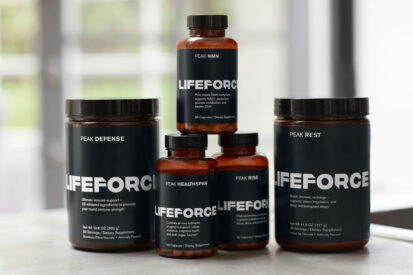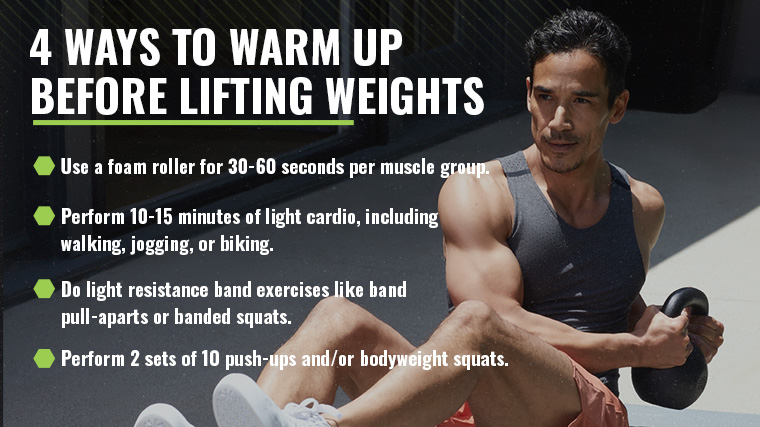It’s been said that getting old isn’t bad when you consider the alternative. And while aging is inevitable, that doesn’t mean your strength training days need to slow down with each new trip around the sun.
There are plenty of ways to not only preserve your strength in the gym but actually increase it as you hit middle age and beyond. Some of these ways include tweaks to your actual exercise routine, while others involve simply getting a bit more sleep or keeping a closer eye on your protein intake.
To learn the best strategies, BarBend has teamed up with Lifeforce, a proactive healthcare platform with its line of advanced supplements, to provide you with seven tips for getting stronger after 40.
Lifeforce

Editor’s Note: The content on BarBend is meant to be informative in nature, but it shouldn’t take the place of advice and/or supervision from a medical professional. While many of our contributors and Experts have respected certifications and degrees, and while some are certified medical professionals, the opinions and articles on this site are not intended for use as diagnosis and/or treatment of health problems.
Get Your Protein
We all know that protein contains the building blocks of muscle and that it’s necessary to build, repair, and maintain muscle mass. While this is true, your body won’t absorb protein as well after 40. (1) As such, you’ll need to find practical ways to insert more of it into your diet.
There are several ways to boost your daily protein intake to its peak levels, and a huge step is to educate yourself on the most abundant natural sources of protein, including the usual suspects like lean meat, fish, eggs, legumes, and tofu. When all else fails, you can also boost your consumption with powdered and liquid supplements.

So, what’s the magic protein number you should hit per day? Opinions differ — a lot — but you should aim for around 1.6 grams per kilogram of body weight. (That’s also roughly around 0.72 grams per pound.) So, for example, if you weigh 200 pounds, you should consume at least 144 grams of protein per day to maintain and build muscle.
Adjust Your Exercise Selection
One surefire sign of aging is when your all-time favorite exercises lead to more aches and pains than gains. The sets of power cleans you once used to supercharge your anatomy now feel like they’re taking a toll on your back, knees, and shoulders. (Along with your ego.)
Much of your overall productivity hinges on the functionality of these key parts of your anatomy, so you’ll want to preserve them at all costs. This may require making some exercise substitutions. For example, trap bar deadlifts can replace standard deadlifts. Not only are they less punishing on your back, but they’re arguably superior for leg development when compared to traditional deadlifts.
Similarly, front squats or goblet squats can replace back squats, leading to less stress on the lumbar spine. And don’t be reluctant to adopt a neutral grip dumbbell bench press over the barbell alternative in order to spare your shoulders.
Maintain Your Energy Levels
Optimizing your approach to training is all well and good, but how are you supposed to continue hoisting heavy weights if your body’s fuel tank always needs to be replenished? To ensure that you can maintain the intensity of your workouts, you need to keep your energy level high and provide your body with the very best nutrition.
Several vitamins and minerals contribute to promoting peak energy levels, including vitamin B1, vitamin B6, vitamin B12, vitamin C, and iron. (2) You can track down food sources containing these micronutrients — including standards like beef, eggs, and salmon — or acquire them by investing in the right supplement.
Lifeforce’s Peak Rise supplement can potentially help here. It has a heaping dose of energizing B vitamins, along with Cereboost®, a potent ginseng extract, and Cognizin®, which can support healthy brain function. And unlike quick-fix energy solutions, Peak Rise doesn’t lead to the dreaded afternoon crash.
Focus on Recovery
Even if your best training days in your mid-40s surpass the pinnacle of what you could muster in college, the effort may not seem to have been worth it the following morning. It’s wise to put additional effort into your post-workout recovery because of the fatigue, soreness, and stiffness that frequently follow training sessions as you get older.
Recovery can take several forms, including light cardio, post-exercise stretching, immediate protein consumption after training, massage, and even immersion in cold tubs. However, you should never underrate the importance of one of the most natural forms of recovery: sleep. (3)
You know how you always ignore the advice to get seven to eight hours of sleep per night? Please don’t. It’s vital for muscle recovery and is key to helping you maintain and improve your strength. While there are a number of ways to ensure a better night’s sleep, here are a few quick tips you can follow right now:
- Avoid caffeine eight hours before bed.
- Don’t use any electronics — phones, tablets, video games — in bed.
- Keep to a consistent bedtime schedule.
Go Lighter When Necessary
Studies have demonstrated the value of training with lighter weights. Specifically, one group of data shows that resistance training at a high volume with light weights can still build muscle even outside of the often-advised range of eight to 12 reps for hypertrophy. (4)

What this means is that you don’t need to flirt with your one-rep max or even perform repetitions with the heaviest weights you can endure in order to see tangible results. With this being the case, you can spare your joints from some of their customary wear and tear by easing up and allowing the burn to build more gradually as your sets develop.
Go on a Walk or Jog
There are several clear advantages to choosing fast-paced forms of cardio, including heightened muscle engagement and the rapid incineration of calories. However, fast cardio often takes a toll on joints, whether it’s the pounding of knees during treadmill runs or the tugging endured by elbows and shoulders during rowing workouts.
To compensate for this, you may prefer a lower-intensity form of cardio, like walking or jogging. In particular, jogging — even as little as five to 10 minutes per day — has been linked to a reduction in all causes of death connected with heart health when compared to people who avoid all cardio. (5) In other words, extending your workout and reducing your intensity can spare your joints and improve the health of your heart.
Find a Trainer
You may have been getting away with training without a workout partner or a trainer for decades while experiencing all the strength and muscle gains you desire. This can also mean you’ve been getting away with substandard form for your entire life without suffering any consequences. One misguided rep performed at an older age can change all of that.
To reduce the likelihood of injury thanks to flawed technique, it’s wise to invest in a personal trainer, even if it’s only for a short time. At least that way, you can get any defects in your training routine diagnosed before they lead to some debilitating problems down the line.
Lifeforce

Take Control of Your Fitness Future
While an improper approach to fitness and nutrition can absolutely compound the problems associated with aging, adopting a holistic approach to wellness will do the opposite. By optimizing your daily routines in both the kitchen and the gym, you can preserve the basic efficiency of your body and help yourself get even stronger past the age of 40.
For an extra boost, check out Lifeforce’s line of supplements that help support your focus and energy levels, including Peak Rise and Peak NMN.
References
- Landi F, Calvani R, Tosato M, Martone AM, Ortolani E, Savera G, D’Angelo E, Sisto A, Marzetti E. Protein Intake and Muscle Health in Old Age: From Biological Plausibility to Clinical Evidence. Nutrients. 2016 May 14;8(5):295.
- Tardy AL, Pouteau E, Marquez D, Yilmaz C, Scholey A. Vitamins and Minerals for Energy, Fatigue and Cognition: A Narrative Review of the Biochemical and Clinical Evidence. Nutrients. 2020 Jan 16;12(1):228.
- Vitale KC, Owens R, Hopkins SR, Malhotra A. Sleep Hygiene for Optimizing Recovery in Athletes: Review and Recommendations. Int J Sports Med. 2019 Aug;40(8):535-543.
- Burd NA, West DW, Staples AW, Atherton PJ, Baker JM, Moore DR, Holwerda AM, Parise G, Rennie MJ, Baker SK, Phillips SM. Low-load high volume resistance exercise stimulates muscle protein synthesis more than high-load low volume resistance exercise in young men. PLoS One. 2010 Aug 9;5(8):e12033.
- Lee DC, Pate RR, Lavie CJ, Sui X, Church TS, Blair SN. Leisure-time running reduces all-cause and cardiovascular mortality risk. J Am Coll Cardiol. 2014 Aug 5;64(5):472-81.
The post 7 Tips to Get Stronger After 40 appeared first on BarBend.

